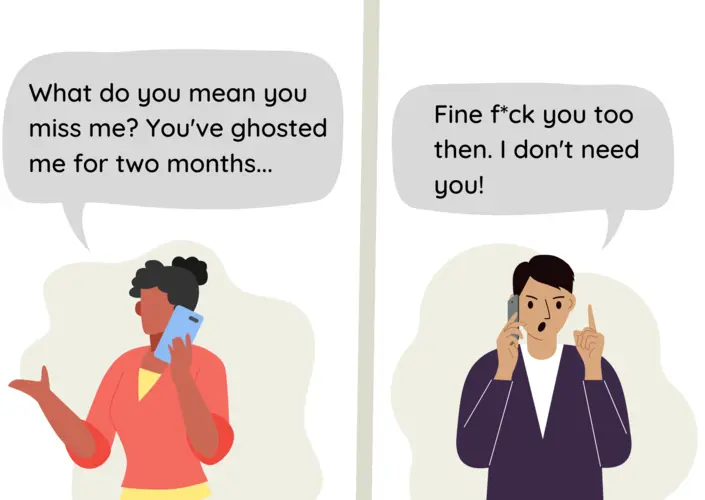Having a relationship of any kind with a narcissist is terribly confusing. The manipulation tactics that they use trick you into believing that the two of you have a special connection, but the second that you get comfortable with that idea, their abusive behavior pushes you away.
Narcissists push you away because they have insecure attachment styles that are either avoidant, anxious, or disorganized attachment. Individuals with insecure attachment styles tend to cope with abandonment issues by not allowing people to get close to them, and not opening up and trusting others.
This article is going to walk you through the insecure attachment styles that narcissists have so you can grasp a comprehensive understanding of the reason that the narcissist in your life pushes you away.
Narcissists Push You Away Because They Have Insecure Attachment Styles
In the 1950’s a psychiatrist named John Bowlby and a psychologist named Mary Ainsworth introduced the Attachment Theory which focuses on the relationships we have with our primary caregivers as infants.
Part of Bowlby’s and Ainsworth’s research focused on understanding how infants respond to a separation, long or short, from their primary caregiver and/or their response when their primary caregivers weren’t readily available.
Their work highlighted three attachment styles: secure, anxious, and avoidant.
But in recent years an additional attachment style has been added to the list, disorganized attachment, and researchers such as Cindy Hazan, PhD, has suggested that these attachment styles also apply in our adult relationships. So, let’s take a closer look at these attachment styles and then get into where they come from!
Secure Attachment
Infants with secure attachment style are sad/upset when separated from their primary caregiver or when their primary caregiver isn’t readily available, but they are quickly soothed upon their return.

Adults with secure attachment styles have feelings of trust and safety in relationships and are capable of forming lasting relationships.
6 Signs of Secure Attachment
- Having the ability to regulate your emotions.
- Easily trusting others.
- Having effective communication skills.
- Having the ability to seek emotional support.
- Feeling comfortable being alone.
- Feeling comfortable in close relationships.
Anxious Attachment
Infants with anxious attachment style are sad/upset when separated from their primary caregiver or when their primary caregiver isn’t readily available, but upon their return, they have a hard time deciding if they want to be soothed by their caregiver or punish their caregiver for being physically/emotionally unavailable.

Adults with anxious attachment styles tend to have problems trusting others. They often worry that people will abandon them, so they often seem clingy or needy.
6 Signs of Anxious Attachment:
- Needing constant contact and support from others.
- Constant need for reassurance that they are good enough.
- Having a hypersensitivity to rejection and abandonment
- Having a high emotional reactivity when someone isn’t available.
- Having difficulty setting and respecting boundaries.
- Being afraid or incapable of being alone.
Avoidant Attachment
Infants with avoidant attachment style are sad/upset when separated from their primary caregiver or when their primary caregiver isn’t readily available, but upon their return, they actively avoid their caregiver.

Adults with avoidant attachment styles tend to have problems with intimacy and low emotional investment in relationships.
6 Signs of Avoidant Attachment
- Persistently avoid emotional or physical intimacy.
- Feeling a strong sense of independence.
- Being uncomfortable expressing their feelings.
- Being dismissive of others.
- Having a hard time trusting people.
- Feeling threatened by anyone who tries to get close to them.
Disorganized Attachment
Disorganized attachment style is a combination of anxious attachment and avoidant attachment styles. Someone who has a disorganized attachment style, may have a hard time trusting people. They often alternate between clinging to their others and distancing themselves from them.

6 Signs of Disorganized Attachment:
- Having a hard time trusting other people.
- Struggling with regulating their own relationships.
- Having a hard time responding and/or connecting to other people’s emotions.
- Alternating between clinging to their partner and distancing themselves from them.
- Having a negative view of themselves and other people.
- Sabotaging relationships, even when them want them.
A Narcissist’s Childhood Upbringing Causes Them to Develop Insecure Attachment Styles
In Bowlby’s and Ainsworth’s research, they say that a good primary caregiver is emotionally responsive, available, and consistent. They then state that a child only needs one good primary caregiver to have a healthy cognitive development.
Children with good primary caregivers often go on to develop secure attachment styles. Children with emotionally unavailable, unresponsive, and inconsistent primary caregivers often go on to develop anxious and avoidant attachment styles.

Interestingly enough, it is believed by professionals that narcissism originates from an abusive and/or unhealthy upbringing with emotionally unavailable, unresponsive, and inconsistent primary caregivers.
This belief has a very broad spectrum of possibilities that could range anywhere from primary caregivers who are physically abusive (e.g. slapping, spanking, etc.) to those whose emotional availability, responsiveness, and consistency is unhealthy (e.g. too much pampering, lack of boundaries, etc.).

However, there are many narcissists who never experienced those forms of abuse but nonetheless, it is believed that their childhood upbringing is the origin of their insecure attachment styles.
Which Insecure Attachment Style Is Most Common For Narcissists to Have?
When Cindy Hazan, PhD suggested the attachment styles also apply in our adult relationships, she described adults with anxious attachment styles as people who are constantly worrying if people love them or not, and become very frustrated when their needs aren’t met.
You can’t help but connect this description with narcissistic personality disorder (NPD) because narcissists have a fear of abandonment, they are constantly worrying about whether or not people love them, and they explode with rage when their needs aren’t met.
To put this theory to the test, we conducted a survey among 400 survivors of narcissistic abuse to determine which attachment style they believed the narcissist in their life had.

FYI, we have done this survey before in our article How Are Narcissists Made, but there we only used 200 survivors of narcissistic abuse, they were all in romantic relationship with the narcissist, and we didn’t give them the “disorganized attachment style” as an option.
73 percent of the participants in that survey believed that the narcissist in their life had anxious attachment style, while 23 percent believed that the narcissist in their life had avoidant attachment style.
It was a really informative survey and we always appreciate it when our community members chime into our articles to give us more information, but now, let’s dive into the results from the survey we conducted for this article!

What Should You Take Away From This Article?
Generally speaking, narcissists push you away because they have insecure attachment styles. Of course, there are going to be situations where they are pushing you away because they are trying to manipulate you into doing something that they want, because they are scared of commitment, or even because they have found a new source of supply. But as a general rule, it is because of their insecure attachment styles!
About the Author

Hey, I’m Elijah.
I experienced narcissistic abuse for three years.
I create these articles to help you understand and validate your experiences.
Thank you for reading, and remember, healing is possible even when it feels impossible.
References:
Anxious Attachment Style: How It Develops & How To Cope
If you have a disorganized attachment type, it might be getting in the way of your relationships
